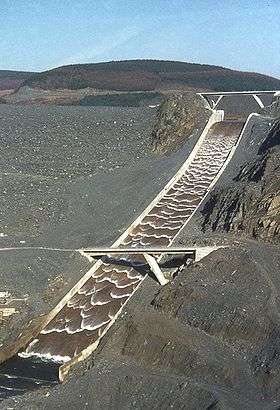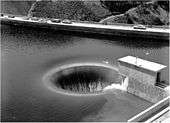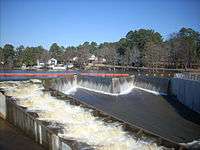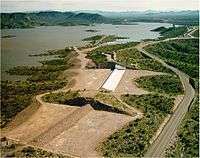Spillway

A spillway is a structure used to provide the controlled release of flows from a dam or levee into a downstream area, typically being the river that was dammed. In the UK they may be known as overflow channels. Spillways release floods so that the water does not overtop and damage or even destroy the dam. Except during flood periods, water does not normally flow over a spillway. In contrast, an intake is a structure used to release water on a regular basis for water supply, hydroelectricity generation, etc. Floodgates and fuse plugs may be designed into spillways to regulate water flow and dam height. Other uses of the term "spillway" include bypasses of dams or outlets of a channels used during highwater, and outlet channels carved through natural dams such as moraines.
Types
A spillway is located at the top of the reservoir pool. Dams may also have bottom outlets with valves or gates which may be operated to release flood flow, and a few dams lack overflow spillways and rely entirely on bottom outlets.

There are two main types of spillways: controlled and uncontrolled.
A controlled spillway has mechanical structures or gates to regulate the rate of flow. This design allows nearly the full height of the dam to be used for water storage year-round, and flood waters can be released as required by opening one or more gates.
An uncontrolled spillway, in contrast, does not have gates; when the water rises above the lip or crest of the spillway it begins to be released from the reservoir. The rate of discharge is controlled only by the depth of water above the reservoir's spillway. Storage volume in the reservoir above the spillway crest can only be used for the temporary storage of floodwater; it cannot be used as water supply storage because it is normally empty.
In an intermediate type, normal level regulation of the reservoir is controlled by the mechanical gates. If inflow to the reservoir exceeds the gate's capacity, an artificial channel called either an auxiliary or emergency spillway that is blocked by a fuse plug dike will operate. The fuse plug is designed to over-top and wash out in case of a large flood, greater than the discharge capacity of the spillway gates. Although it may take many months to restore the fuse plug and channel after such an operation, the total damage and cost to repair is less than if the main water-retaining structures had been overtopped. The fuse plug concept is used where it would be very costly to build a spillway with capacity for the probable maximum flood.
Open channel spillways
Chute spillways
Chute spillways are common and basic in design as they transfer excess water from behind the dam down a smooth decline into the river below. These are usually designed following an ogee curve. Most often, they are lined on the bottom and sides with concrete to protect the dam and topography. They may have a controlling device and some are thinner and multiply lined if space and funding are tight. In addition, they are not always intended to dissipate energy like stepped spillways. Chute spillways can be ingrained with a baffle of concrete blocks but usually have a 'flip lip' and/or dissipator basin which creates a hydraulic jump, protecting the toe of the dam from erosion.[1]
Stepped spillways

Stepped channels and spillways have been used for over 3,000 years.[2] Recently, new construction materials (e.g. RCC, gabions) and design techniques (e.g. embankment overtopping protection) have increased the interest in stepped spillways and chutes.[3][4] The steps produce considerable energy dissipation along the chute[5] and reduce the size of the required downstream energy dissipation basin.[6][7]
Research is still active on the topic, with newer developments on embankment dam overflow protection systems,[7] converging spillways[8] and small weir design.[9]
Bell-mouth spillways

Some spillways are designed like an inverted bell so that water can enter all around the perimeter. These uncontrolled spillway devices are also called morning glory,[10] glory hole[10] or bell-mouth[11] spillways. In areas where the surface of the reservoir may freeze, this type of spillway is normally fitted with ice-breaking arrangements to prevent the spillway from becoming ice-bound.
In some cases bell-mouth spillways are gate controlled. The spillway at Hungry Horse Dam (pictured right), the highest morning glory structure in the world,[12] is controlled by a 64-by-12-foot (19.5 by 3.7 m) ring gate. However the largest remains in Geehi Dam, measuring 105 ft (32 m) in diameter at the lake's surface.[13][14][15]
Siphon spillway
A siphon makes use of the difference in the height between the intake and the outlet to create a pressure difference needed to remove excess water. Siphons however require priming or the removal of air in the bend in order for them to function and most siphon spillways are designed with a system that makes use of water to remove the air and automatically prime the siphon. One such design is the volute siphon which makes use of water forced into a spiral vortex by volutes or fins on a funnel that draw air out of the system. The priming happens automatically when the water level rises above the inlets that are used to drive the priming process.[16]
Other types
Other spillway types include an ogee crest which over-tops a dam, a side channel that wraps around the topography of a dam and a labyrinth which uses a 'zig-zag' design to increase the sill length for a thinner design and increased discharge. There is also a drop inlet which resembles an intake for a hydroelectric power plant but transfers water from behind the dam directly through tunnels to the river downstream.[17]
Design considerations
One parameter of spillway design is the largest flood it is designed to handle. The structures must safely withstand the appropriate spillway design flood (SDF). A 100-year recurrence interval is the flood magnitude expected to be exceeded on the average of once in 100 years. It may also be expressed as an exceedance frequency with a one per cent chance of being exceeded in any given year. The volume of water expected during the design flood is obtained by hydrologic calculations of the upstream watershed. The return period is set by dam safety guidelines, based on the size of the structure and the potential loss of human life or property downstream.
Energy dissipation

As water passes over a spillway and down the chute, potential energy converts into increasing kinetic energy. Failure to dissipate the water's energy can lead to scouring and erosion at the dam's toe (base). This can cause spillway damage and undermine the dam's stability.[18] To put this energy in perspective, the spillways at Tarbela Dam could, at full capacity, produce 40,000 MW; about ten times the capacity of its power plant.[19]
The energy can be dissipated by addressing one or more parts of a spillway's design.
- Steps
First, on the spillway surface itself by baffles and/or steps along the spillway.
- Flip bucket
Second, at the base of a spillway, a flip bucket can create a hydraulic jump and deflect water upwards.
- Ski jump
A ski jump can also direct water horizontally and eventually down into a plunge pool or two ski jumps can direct their water discharges to collide with one another.[19][20]
- Stilling basin
Third, a stilling basin at the terminus of a spillway serves to further dissipate energy and prevent erosion. They are usually filled with a relatively shallow depth of water and sometimes lined with concrete. A number of velocity-reducing components can be incorporated into the their design to include chute blocks, baffle blocks, wing walls, surface boils or an end sill.[21]
Safety
Spillway gates may operate suddenly without warning, under remote control. Trespassers within the spillway run the risk of drowning. Spillways are usually fenced and equipped with locked gates to prevent casual trespassing within the structure. Warning signs, sirens, and other measures may be in place to warn users of the downstream area of sudden release of water. Operating protocols may require "cracking" a gate to release a small amount of water to warn persons downstream.
The sudden closure of a spillway gate can result in the stranding of fish, and this is also usually avoided.
Gallery
-

A labyrinth spillway and a fish ladder (left) of the Hope Mills Dam in North Carolina
-

Spillway with flip bucket at Burdekin Dam.
-

Water enters Hoover Dam's Arizona side channel drum-gate spillway (left) during the 1983 floods.
-

A labyrinth spillway entrance (bottom) at the Ute Dam in New Mexico.
-

An ogee-type spillway at the Crystal Dam in Colorado.
-

An emergency spillway with fuse plug (bottom) and an auxiliary ogee spillway (top) at New Waddell Dam.
-

Semicircular spillways of Ohzuchi Dam (Shiga Pref., Japan)
-

Looking down into the Bell mouth spillway at Llyn Celyn
-

Low-height spillway of Bonneville Dam with Sluice gates
See also
References
- ↑ Henry H., Thomas. "Chute spillways, The Engineering of Large Dams". Retrieved 2010-07-05.
- ↑ H. Chanson (2001–2002). Historical Development of Stepped Cascades for the Dissipation of Hydraulic Energy. Transactions of the Newcomen Society, Vol. 71, No. 2, pp. 295-318.
- ↑ H. Chanson (1995). Hydraulic Design of Stepped Cascades, Channels, Weirs and Spillways. Pergamon. ISBN 0-08-041918-6.
- ↑ H. Chanson (2002). The Hydraulics of Stepped Chutes and Spillways. Balkema. ISBN 90-5809-352-2.
- ↑ N. Rajaratnam (1990). Skimming Flow in Stepped Spillways. Jl of Hyd. Engrg., ASCE, Vol. 116, No. 4, pp. 587-591. Discussion : Vol. 118, No. 1, pp. 111-114.
- ↑ H. Chanson (2001). Hydraulic Design of Stepped Spillways and Downstream Energy Dissipators. Dam Engineering, Vol. 11, No. 4, pp. 205-242.
- 1 2 C.A. Gonzalez & H. Chanson (2007). Hydraulic Design of Stepped Spillways and Downstream Energy Dissipators for Embankment Dams. Dam Engineering, Vol. 17, No. 4, pp. 223-244.
- ↑ S.L. Hunt, S.R. Abt & D.M. Temple (2008). Hydraulic Design of Stepped Spillways and Downstream Energy Dissipators for Embankment Dams. Impact of Converging Chute Walls for Roller Compacted Concrete Stepped Spillways.
- ↑ I. Meireles, J. Cabrita & J. Matos (2006). Non-Aerated Skimming Flow Properties on Stepped Chutes over Small Embankment Dams In:Hydraulic Structures: a Challenge to Engineers and Researchers Proceedings of the International Junior Researcher and Engineer Workshop on Hydraulic Structures IJREWHS'06, 205 pages. St. Lucia, Qld.: University of Queensland, Division of Civil Engineering. ISBN 1-86499-868-7. External link in
|title=(help) - 1 2 "Lake Berryessa, Bureau of Reclamation, Mid-Pacific Region". Dept. of Interior. 2010-04-26. Retrieved 2011-02-19.
- ↑ Ratnayaka, Don D.; Brandt, Malcolm J.; Johnson, K. Michael (2009). Twort's water supply. (6th ed.). Oxford: Butterworth-Heinemann. p. 177. ISBN 0-7506-6843-1.
- ↑ "Hungry Horse Dam". U.S. Bureau of Reclamation. Retrieved 1 November 2010.
- ↑ http://www.snowyhydro.com.au/energy/hydro/dams/
- ↑ Stene, Eric A. "Hungry Horse Project History" (PDF). U.S. Bureau of Reclamation. Retrieved 1 November 2010.
- ↑ Storey, Brit Allan (2008). The Bureau of Reclamation: history essays from the centennial symposium, Volume 1. United States Government Printing Office. p. 36. ISBN 978-0-16-081822-6. Retrieved 1 November 2010.
- ↑ Rao, Govinda NS (2008). "Design of Volute Siphon." (PDF). Journal of the Indian Institute of Science 88 (3): 915–930.
- ↑ "Hydraulic Design, Types of Spillways" (PDF). Rowan University. Retrieved 2010-07-05.
- ↑ Irrigation and Water Power Engineering. Firewall Media. 1992. pp. 500–501. ISBN 81-7008-084-3.
|first1=missing|last1=in Authors list (help) - 1 2 Novak, P. (2008). Hydraulic structures (4. ed., repr. ed.). London [u.a.]: Taylor & Francis. pp. 244–260. ISBN 0-415-38625-X.
- ↑ Chanson, Hubert (2002). The hydraulics of stepped chutes and spillways. Exton, PA: A. A. Balkema Publishers. p. 1. ISBN 90-5809-352-2.
- ↑ Hager, Willi H. (1992). Energy dissipators and hydraulic jump. Dordrecht u.a.: Kluwer. pp. 213–218. ISBN 0-7923-1508-1.
External links
| Wikimedia Commons has media related to Spillways. |
| Look up spillway in Wiktionary, the free dictionary. |
- Chris, Fish. "The Glory Hole". - information, images, and construction information about the Lake Berryessa glory hole.